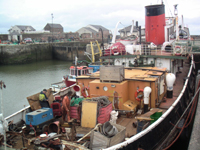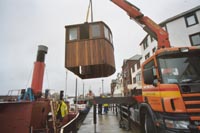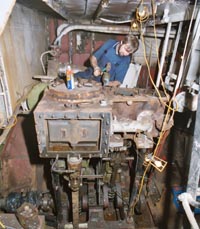|

|
VIC
96 is one of a few vessels now left which were built in a hurry
for wartime duties.
VIC
stands for Victualling Inshore Craft. They were built principally
to take supplies out to larger ships at anchor.
|
|

|
The
design was based on the success of the Clyde Puffers which had
proved themselves several decades earlier.
Like
TID tugs they were designed with simplicity in mind, using mainly
flat steel plates.
|
|

|
Although
diesel had become the normal means of propulsion, a traditional
compound steam engine was used in order not to waste high tech
skills during the war.
VIC
96 was built in 1945 by Richard Dunston Ltd of Thorne, Humberside.
She
served at Sheerness Dockyard from 1946 until February 1959 and
thereafter at Chatham Dockyard, known as C668, until August
1972.
|
|

|
Bought
by a Mr. R.W. Fielding of Dublin she left Chatham under tow,
then laid up in the Royal Group of docks in the East End of
London until she was removed to Limehouse Basin, Regents Canal
Dock, London.
This
was when Martin Stevens, now chairman of the Medway Maritime
Trust, first became aware of VIC 96 and took the accompanying
black and white photographs.
|
|

|
Most
of the Medway Maritime Museum fleet was also in Limehouse basin
- the steam tugs Goliath, Cervia and John H Amos. |
| |
In
1981 she was sold again to become part of a collection of steamships
at Maryport in Cumbria.
The
voyage from London was made under her own steam, stopping at
Newcastle, and onwards through the Caledonian Canal and down
the West Coast to Maryport.
|
|

|
The
Museum at Maryport was run by the Trelaugh family who found it
easier to acquire vessels than to maintain them. The museum failed.
Several
ships were scrapped, including the steam tug Goliath which had
been sold to the museum by Michael List Brain.
|
|

|
VIC 96 was among those which survived to be bought by Allerdale
District Council in January 1986. A restoration programme was
set up, first through the Community Programme and subsequently
Employment Training.
The
last two vessels, (the other was the steam tug Flying Buzzard,
ex Harecraig 2 from Dundee), were sold by the local council
for 50 pence each on condition that they were preserved.
|
|

|
Unfortunately
the person who bought them, Giles Pattison, was interested in
more-than-covering his costs rather than in preservation. Flying
Buzzard was advertised for £60,000 and VIC 96 for £35,000.
The
price of the VIC eventually dropped to £20,000, then to
£6,000.
At
this stage Martin Stevens thought it was worth keeping in touch.
|
 |
After
a visit to Maryport, Giles Pattison agreed that rather than
donate it to the Medway Maritime Trust he would cover his costs
and swap it for a woodstove!
( Martin Stevens runs a business selling woodstoves ).
By
the time he was telephoned to be told that the stove was ready
for delivery, he had sold the ship for £2,500 to Christopher
Potter from Carlisle who wanted it as a houseboat.
Once
again Martin Stevens kept in contact.
|
|

|
A
few months later the new owner realised that VIC 96 was not
a houseboat,
and Martin finally managed to get the ship under his control
by paying him £2000.
The alternative was for Chistopher Potter to scrap it.
This
is the nerve-racking part of the story.
VIC
96 had previously sunk at its moorings and was in dire need
of a thirty year makeover. Gales were forecast for the north
west of England for the early winter of 2003, and there were
signs of more leaks.
|
 |
Again
Martin visited Maryport, this time with friend, a trusted steam
engineer Julian Hopper. They "surveyed" the vessel
with the help of the boss of Anglia Waterblast, Mel Mitchell,
who subsequently gave a quote for stabilising the condition
of the ship.
Reasonable
as the quote was, it could not be afforded on top of other commitments.
Without a favourable surveyor's report the vessel could not
be insured. Julian
and Martin worked out a plan.
|
|

|
Julian knew that his father-in-law, Derek Gransden, had always
wanted a Clyde Puffer, and he already had an interest in landbased
steam artefacts including a Sentinel steam wagon.
A
discussion established that he was not prepared to take on such
a commitment by himself, but would be prepared to share the
adventure with like-minded friends.
|
|

|
They
calculated the amount of money needed to bring the ship south,
and the investment which each "shareholder" would
be prepared, in effect, to throw away, thus arriving at the
number of people.
Seven
of his friends were invited for a meal, and for reasons which
each one managed to justify to himself, ranging from extending
an existing hobby to a new subject for dinner-party conversation,
they signed up.
|
|

|
Three
more have now joined in, forming the VIC 96 Trust.
Martin's
£2000 was repaid, and the new owners have now made regular
working visits to the ship. A large skip was filled on the first
visit.
|
|

|
One
of the team with workshop facilities had the windlass delivered
home for his 2003 winter project.
|
|

|
Another
rebuilt the wheelhouse. |
|

|
The
boiler has been retubed, steam engines overhauled, valves restored,
and the hull has received long overdue attention in the form
of 70 square metres of new plate.
The
plan is to steam south during the summer of 2009 to a berth
at Chatham via the Caledonian Canal and the east coast.
|
|

|
This
is not the end of the story, but another not very important
part of our maritime heritage has been rescued and given the
chance of surviving another generation.
Link
to the VIC 96 website: www.vic96.co.uk
|